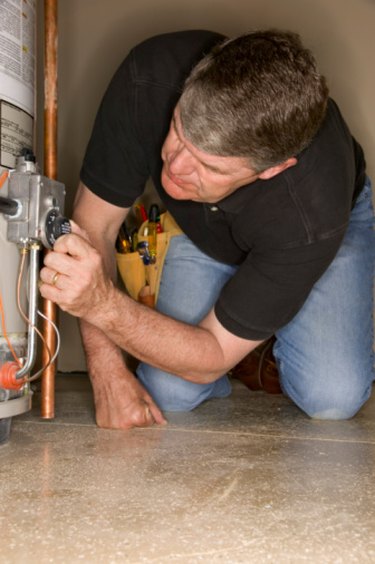Things You'll Need
Pipe joint compound
Slip-joint pliers
Rag
CPVC 3/4 MPT-by-3/4 hub
Tape measure
CPVC tubing cutter or saw
3/4-inch CPVC Pipe
CPVC primer and cement

Building codes require temperature/pressure relief (TPR) valves with discharge pipes on all new water heater installations. If the pressure in the tank exceeds 150 psi, or the temperature exceeds 210 degrees Fahrenheit, the TPR valve opens to release the pressure. Scalding water and steam escape the tank through the valve and tube to relieve the pressure. Local building codes vary, but most require a catch pan under the water heater with a discharge pipe that ends above the rim of the pan to provide an air gap between the pipe and a pan full of water.
Step 1
Brush pipe joint compound on the threads on the TPR valve using the brush supplied with the pipe joint compound. Thread the TPR valve clockwise into the pressure relief fitting on the water heater and tighten it by hand until it is tight.
Video of the Day
Step 2
Hold the TPR valve with the slip-joint pliers. Turn the valve clockwise one additional turn to point the TPR valve outlet at the floor, or at the nearest side of the water heater if the TPR valve is located on the top of the water heater. Wipe off any excess pipe joint compound with a damp rag.
Step 3
Thread the MPT fitting into the TPR valve outlet. Measure from the nut portion of the MPT fitting to the top of the catch pan and subtract two inches for the length of the discharge tube. Cut a piece of CPVC pipe with the pipe cutter to the length measured for the discharge tube.
Step 4
Remove the CPVC fitting from the TPR valve. Open the CPVC primer. Coat the inside of the hub portion of the fitting and one end of the CPVC pipe with primer using the supplied primer brush. Close the primer immediately.
Step 5
Open the CPVC cement. Coat the inside of the fitting and the end of the pipe with cement using the supplied cement brush. Close the glue container as soon as you are done. Insert the end of the pipe into the fitting as you turn the pipe 1/4 turn. Hold the pipe and fitting together for 30 seconds as the cement bonds the pipe and fitting together.
Step 6
Brush pipe joint compound on the fitting threads. Screw the fitting clockwise into the TPR valve outlet until the fitting is hand tight. Tighten the fitting using the slip-joint pliers, but use care not to over tighten.
Tip
If the TPR valve is on top of the water heater, install a short piece of CPVC from the valve to the side of the water heater, then use a 90-degree fitting to make the turn towards the floor and add a second pipe to carry the discharge down to the catch pan.
Some jurisdictions require a metal pipe, which usually is copper.
Warning
Ensure there is an air gap between the top of the catch pan and the bottom of the pipe. This prevents water from siphoning back into the tank and contaminating the water supply system.
Video of the Day